Biermann Ch. Handbook of Pulping and Papermaking
Подождите немного. Документ загружается.

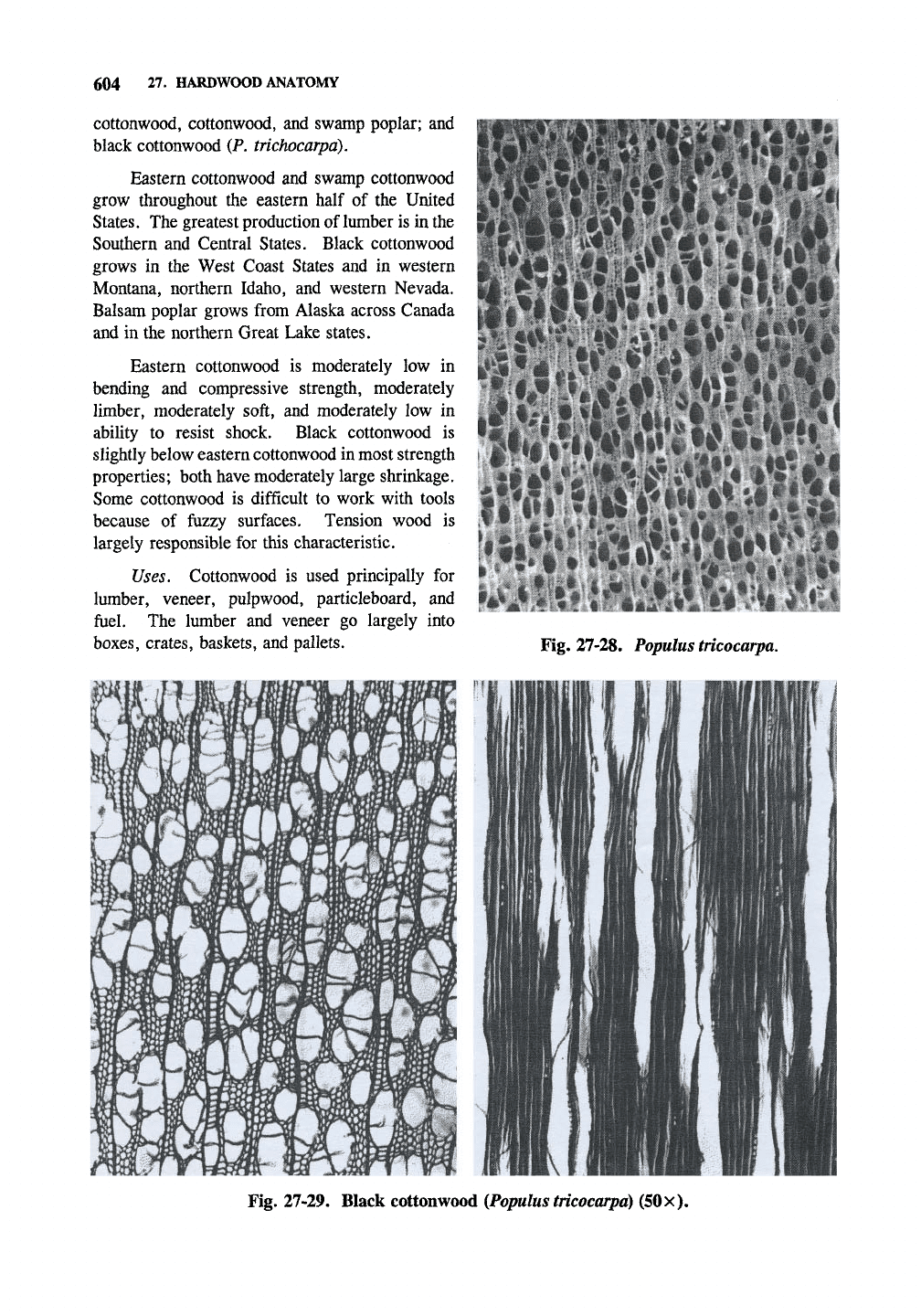
604 27. HARDWOOD ANATOMY
Cottonwood, Cottonwood, and swamp poplar; and
black Cottonwood (P. trichocarpa).
Eastern cottonwood and swamp Cottonwood
grow throughout the eastern half of the United
States. The greatest production of lumber is in the
Southern and Central States. Black cottonwood
grows in the West Coast States and in western
Montana, northern Idaho, and western Nevada.
Balsam poplar grows from Alaska across Canada
and in the northern Great Lake states.
Eastern cottonwood is moderately low in
bending and compressive strength, moderately
limber, moderately soft, and moderately low in
ability to resist shock. Black cottonwood is
slightly below eastern cottonwood in most strength
properties; both have moderately large shrinkage.
Some cottonwood is difficult to work with tools
because of fiizzy surfaces. Tension wood is
largely responsible for this characteristic.
Uses. Cottonwood is used principally for
lumber, veneer, pulpwood, particleboard, and
fuel. The lumber and veneer go largely into
boxes,
crates, baskets, and pallets.
Fig. 27-28. Populus tricocarpa.
Fig. 27-29. Black cottonwood
{Populus tricocarpa)
(50x).
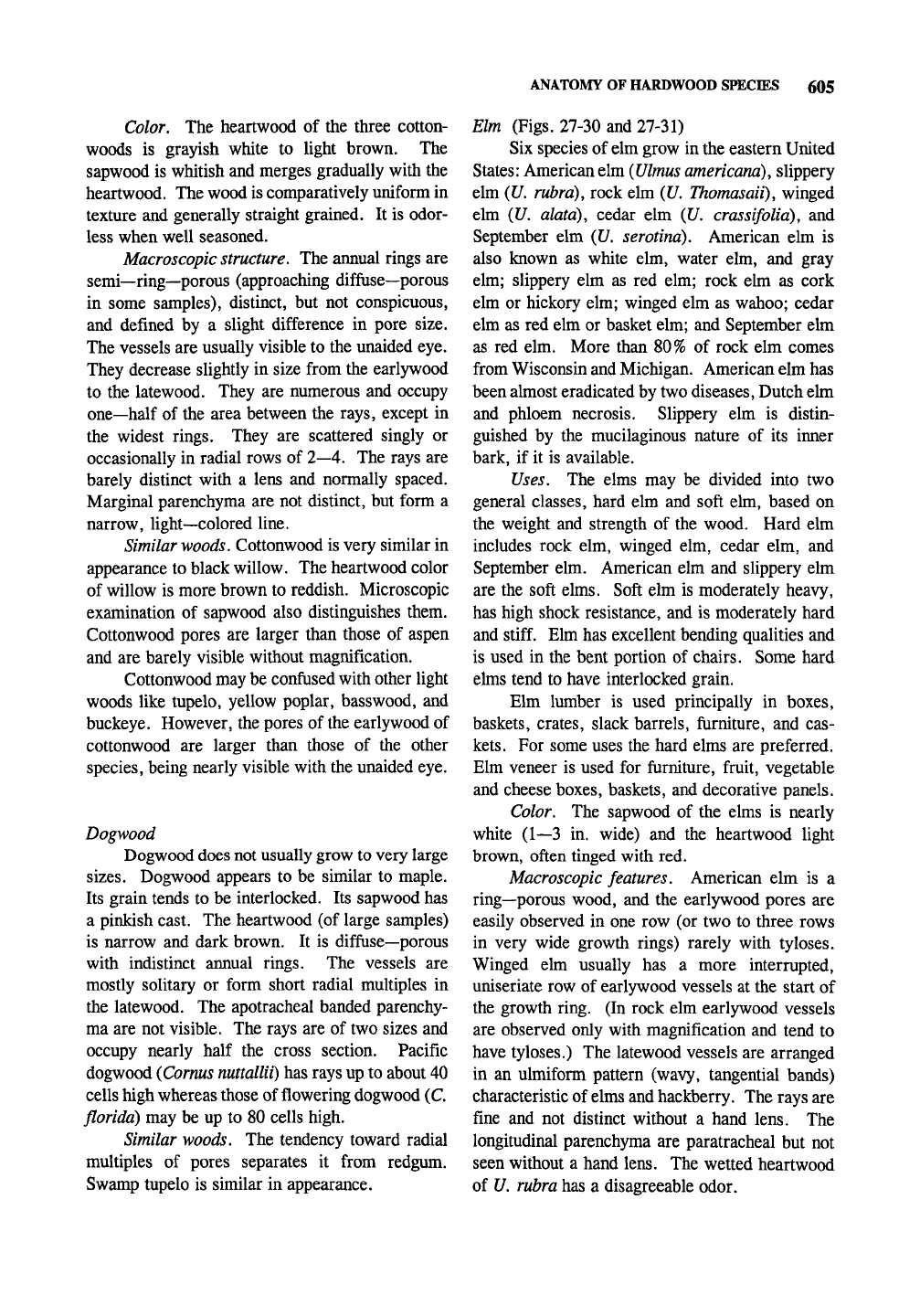
ANATOMY OF HARDWOOD SPECIES 605
Color. The heartwood of the three cotton-
woods is grayish white to light brown. The
sapwood is whitish and merges gradually with the
heartwood. The wood is comparatively uniform in
texture and generally straight grained. It is odor-
less when well seasoned.
Macroscopic
structure.
The annual rings are
semi—ring—porous (approaching diffuse—porous
in some samples), distinct, but not conspicuous,
and defined by a slight difference in pore size.
The vessels are usually visible to the unaided eye.
They decrease slightly in size from the earlywood
to the latewood. They are numerous and occupy
one—half of the area between the rays, except in
the widest rings. They are scattered singly or
occasionally in radial rows of
2—4.
The rays are
barely distinct with a lens and normally spaced.
Marginal parenchyma are not distinct, but form a
narrow, light—colored line.
Similar
woods.
Cottonwood is very similar in
appearance to black willow. The heartwood color
of willow is more brown to reddish. Microscopic
examination of sapwood also distinguishes them.
Cottonwood pores are larger than those of aspen
and are barely visible without magnification.
Cottonwood may be confused with other light
woods like tupelo, yellow poplar, basswood, and
buckeye. However, the pores of the earlywood of
Cottonwood are larger than those of the other
species, being nearly visible with the unaided eye.
Dogwood
Dogwood does not usually grow to very large
sizes.
Dogwood appears to be similar to maple.
Its grain tends to be interlocked. Its sapwood has
a pinkish cast. The heartwood (of large samples)
is narrow and dark brown. It is diffuse—porous
with indistinct annual rings. The vessels are
mostly solitary or form short radial multiples in
the latewood. The apotracheal banded parenchy-
ma are not visible. The rays are of two sizes and
occupy nearly half the cross section. Pacific
dogwood
{Cornus nuttallii)
has rays up to about 40
cells high whereas those of flowering dogwood (C
florida) may be up to 80 cells high.
Similar woods. The tendency toward radial
multiples of pores separates it from redgum.
Swamp tupelo is similar in appearance.
Elm (Figs. 27-30 and 27-31)
Six species of elm grow in the eastern United
States: American elm
{Ulmus
americana), slippery
elm (U. rubra), rock elm (U. Thomasaii), winged
elm (U. alata), cedar elm (U. crassifolia), and
September elm (C/. serotina). American elm is
also known as white elm, water elm, and gray
elm; slippery elm as red elm; rock elm as cork
elm or hickory elm; winged elm as wahoo; cedar
elm as red elm or basket elm; and September elm
as red elm. More than 80% of rock elm comes
from Wisconsin and Michigan. American elm has
been almost eradicated by two diseases, Dutch ehn
and phloem necrosis. Slippery elm is distin-
guished by the mucilaginous nature of its inner
bark, if it is available.
Uses. The elms may be divided into two
general classes, hard elm and soft elm, based on
the weight and strength of the wood. Hard elm
includes rock elm, winged elm, cedar elm, and
September elm. American elm and slippery elm
are the soft elms. Soft elm is moderately heavy,
has high shock resistance, and is moderately hard
and
stiff.
Elm has excellent bending qualities and
is used in the bent portion of chairs. Some hard
elms tend to have interlocked grain.
Elm lumber is used principally in boxes,
baskets, crates, slack barrels, furniture, and cas-
kets.
For some uses the hard elms are preferred.
Elm veneer is used for furniture, fruit, vegetable
and cheese boxes, baskets, and decorative panels.
Color. The sapwood of the elms is nearly
white (1—3 in. wide) and the heartwood light
brown, often tinged with red.
Macroscopic features. American elm is a
ring—porous wood, and the earlywood pores are
easily observed in one row (or two to three rows
in very wide growth rings) rarely with tyloses.
Winged elm usually has a more interrupted,
uniseriate row of earlywood vessels at the start of
the growth ring. (In rock elm earlywood vessels
are observed only with magnification and tend to
have tyloses.) The latewood vessels are arranged
in an ulmiform pattern (wavy, tangential bands)
characteristic of
elms
and hackberry. The rays are
fine and not distinct without a hand lens. The
longitudinal parenchyma are paratracheal but not
seen without a hand lens. The wetted heartwood
of U. rubra has a disagreeable odor.
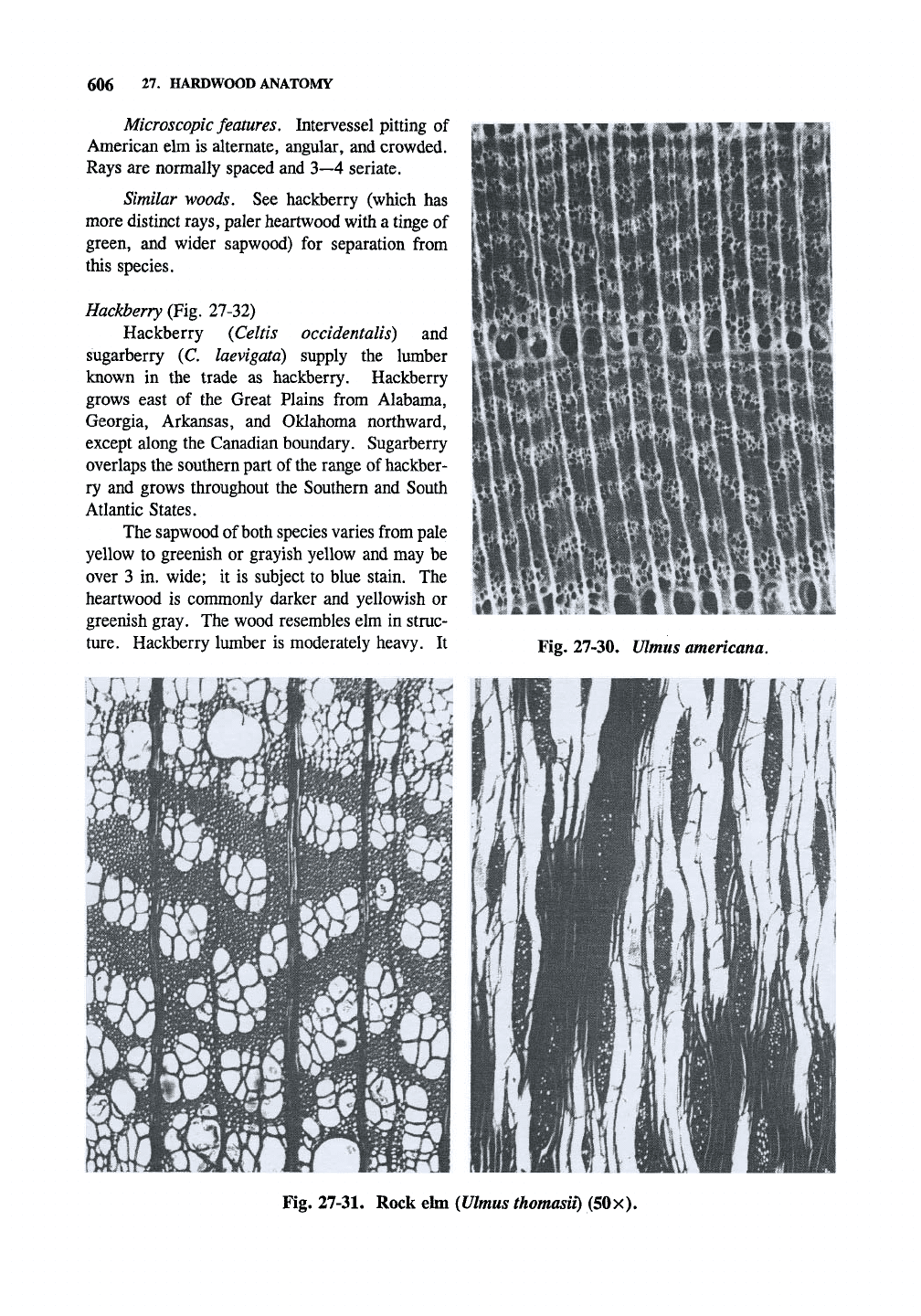
606
27.
HARDWOOD ANATOMY
Microscopic
features. Intervessel pitting of
American elm is alternate, angular, and crowded.
Rays are normally spaced and 3—4 seriate.
Similar woods. See hackberry (which has
more distinct rays, paler heartwood with a tinge of
green, and wider sapwood) for separation from
this species.
Hackberry (Fig. 27-32)
Hackberry (Celtis occidentalis) and
sugarberry (C. laevigata) supply the lumber
known in the trade as hackberry. Hackberry
grows east of the Great Plains from Alabama,
Georgia, Arkansas, and Oklahoma northward,
except along the Canadian boundary. Sugarberry
overlaps the southern part of
the
range of hackber-
ry and grows throughout the Southern and South
Atlantic States.
The sapwood of both species varies from pale
yellow to greenish or grayish yellow and may be
over 3 in. wide; it is subject to blue stain. The
heartwood is commonly darker and yellowish or
greenish gray. The wood resembles elm in struc-
ture.
Hackberry lumber is moderately heavy. It
Fig. 27-30. Ulmus americana.
Fig.
27-31.
Rock elm {Ulmus
thomasii)
(50x).

ANATOMY OF HARDWOOD SPECIES 607
Fig. 27-32. Hackberry (Celtis
occidentalis)
(50x).
is moderately strong in bending, moderately weak
in compression parallel to the grain, moderately
hard to hard, high in shock resistance, but low in
stiffness. It has moderately large to large shrink-
age.
Hackberry lumber keeps its shape well
during seasoning.
Hackberry is cut into lumber, with small
amounts going into dimension stock and veneer.
It is used for furniture and some for containers.
Macroscopic features. Hackberry is a ring-
porous wood; the earlywood vessels form a ring
that is 2—3 pores wide, except in narrow growth
rings.
The earlywood pores of the heartwood are
partly occluded with tyloses. The latewood ves-
sels are in a ulmiform arrangement. The rays are
normally spaced and relatively conspicuous.
Longitudinal parenchyma are paratracheal, being
intermixed with latewood vessels and vascular
tracheids, and visible only with a hand lens.
Hackberry is similar to elm but the large
earlywood vessels are in more than one row, the
ulmiform pattern of latewood vessels is less
pronounced, the rays are more distinct, and the
heartwood may have a greenish tinge.
Hickories (Figs. 27-33 and 27-34)
The hickories are divided into two groups,
the pecan hickories and the true hickories, based
on the twigs, leaves, and fruit. It is difficult, even
with a microscope, to distinguish among the
species, or even the groups, except for the water
hickory. The hickories range throughout the
eastern
U.S.
The wood is very heavy and exceed-
ingly hard and tough.
Color. The sapwoodis 1—2 in., occasionally
to 3 in., wide. The heartwood is brown to reddish
brown. It has no characteristic odor or taste.
Macroscopic
features. Individual pores are
visible, but the zone of large pores is not sharply
outlined as in the oaks and the ashes. The
earlywood has a ring of large vessels of
1
to 2 (or
3 pores in wide rings) width. The pores decrease
in size somewhat gradually toward the latewood.
In the latewood, the pores are not numerous,
isolated, or in radial rows of
2—3.
The rays are very small and seen without
magnification on radial surfaces only. The
apotracheal, banded parenchyma are distinct with
a lens and form numerous fine, light—colored,

608
27.
HARDWOOD ANATOMY
tangential bands that do not encircle the vessels (as
in ash), but usually extending between the vessels
or passing around them to one side. The paren-
chyma form a net—like appearance with the rays.
Similar woods. The hickories are distin-
guished from the other ring—porous woods by the
numerous fine, tangential lines of parenchyma and
the presence of few pores in the latewood. Per-
simmon is similar but has finer tangential lines of
parenchyma and its rays are in horizontal rows
that are plainly visible on tangential surfaces as
very fine bands across the grain.
Pecan hickories
Species of the pecan group include bitternut
hickory (Gary a cordiformis), pecan (C.
illinoensis),
water hickory (C aquatica), and
nutmeg hickory (C. myristicaeformis). Bitternut
hickory grows throughout the eastern half of the
United States. Pecan hickory grows from central
Texas and Louisiana to Missouri and Indiana.
Water hickory grows from Texas to South Caroli-
na. Nutmeg hickory occurs principally in Texas
and Louisiana.
Fig. 27-33. A pecan hickory; Carya spp.
Fig. 27-34. Shagbark hickory, a true hickory {Carya
ovata)
(50x).
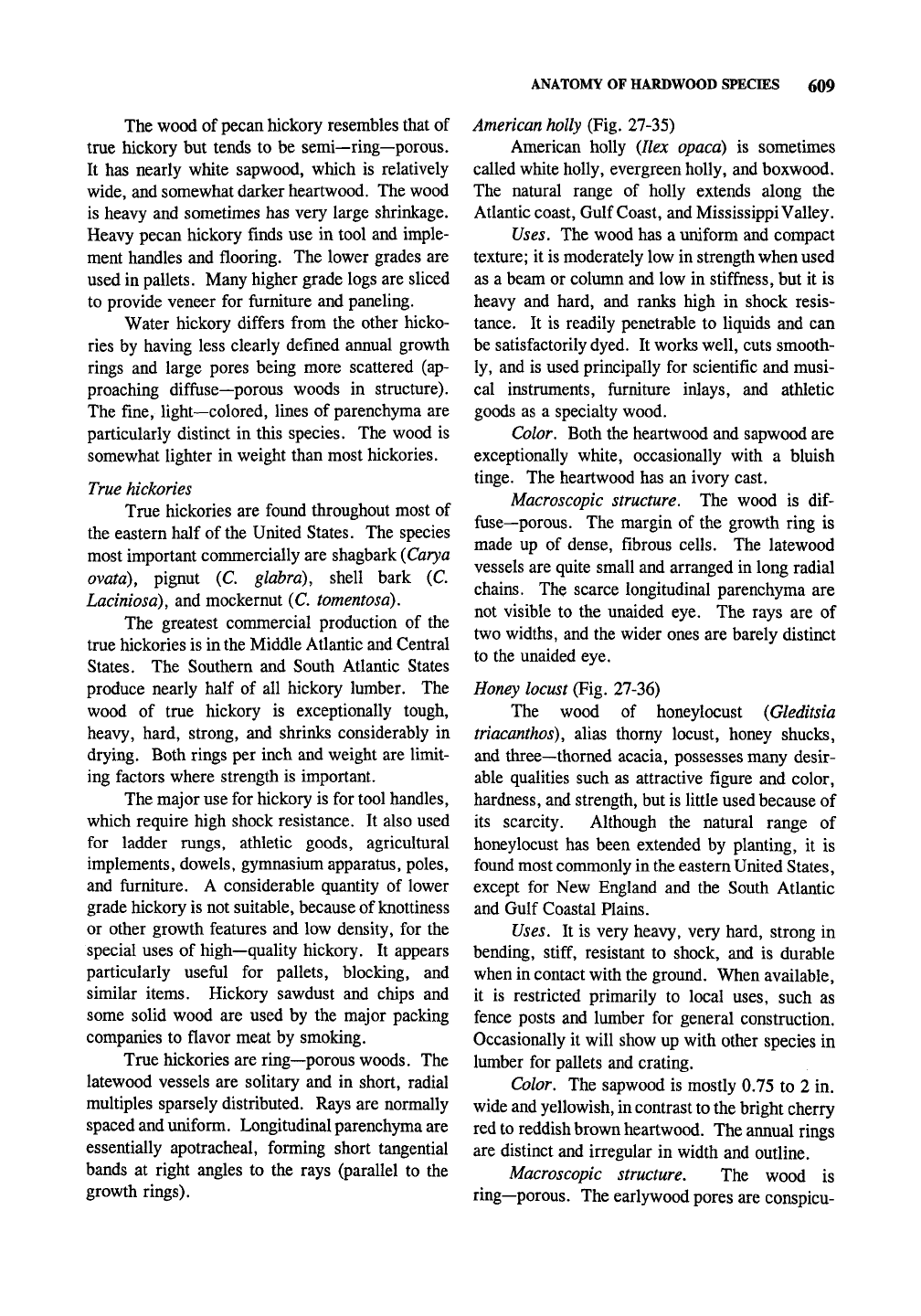
ANATOMY OF HARDWOOD SPECIES
609
The wood
of
pecan hickory resembles that
of
true hickory
but
tends
to be
semi—ring—porous.
It
has
nearly white sapwood, which
is
relatively
wide, and somewhat darker heartwood. The wood
is heavy
and
sometimes
has
very large shrinkage.
Heavy pecan hickory finds
use in
tool
and
imple-
ment handles
and
flooring.
The
lower grades
are
used
in
pallets. Many higher grade logs
are
sliced
to provide veneer
for
furniture
and
paneling.
Water hickory differs from
the
other hicko-
ries
by
having less clearly defined annual growth
rings
and
large pores being more scattered
(ap-
proaching diffuse—porous woods
in
structure).
The fine, light—colored, lines
of
parenchyma
are
particularly distinct
in
this species.
The
wood
is
somewhat lighter
in
weight than most hickories.
True hickories
True hickories
are
found throughout most
of
the eastern half
of
the United States.
The
species
most important commercially
are
shagbark
{Carya
ovata),
pignut
(C.
glabra), shell bark
(C.
Laciniosa),
and
mockernut (C. tomentosa).
The greatest commercial production
of the
true hickories
is
in the Middle Atlantic and Central
States.
The
Southern
and
South Atlantic States
produce nearly half
of all
hickory lumber.
The
wood
of
true hickory
is
exceptionally tough,
heavy, hard, strong,
and
shrinks considerably
in
drying. Both rings
per
inch
and
weight
are
limit-
ing factors where strength
is
important.
The major use
for
hickory
is for
tool handles,
which require high shock resistance.
It
also used
for ladder rungs, athletic goods, agricultural
implements, dowels, gymnasium apparatus, poles,
and furniture.
A
considerable quantity
of
lower
grade hickory is
not
suitable, because
of
knottiness
or other growth features
and low
density,
for the
special uses
of
high—quality hickory.
It
appears
particularly useful
for
pallets, blocking,
and
similar items. Hickory sawdust
and
chips
and
some solid wood
are
used
by the
major packing
companies
to
flavor meat
by
smoking.
True hickories
are
ring—porous woods.
The
latewood vessels
are
solitary
and in
short, radial
multiples sparsely distributed. Rays
are
normally
spaced and uniform. Longitudinal parenchyma are
essentially apotracheal, forming short tangential
bands
at
right angles
to the
rays (parallel
to the
growth rings).
American holly (Fig. 27-35)
American holly (Ilex opaca)
is
sometimes
called white holly, evergreen holly, and boxwood.
The natural range
of
holly extends along
the
Atlantic coast. Gulf Coast, and Mississippi Valley.
Uses.
The
wood has
a
uniform
and
compact
texture;
it
is moderately low
in
strength when used
as
a
beam
or
column
and low in
stifftiess,
but it is
heavy
and
hard,
and
ranks high
in
shock resis-
tance.
It is
readily penetrable
to
liquids
and can
be satisfactorily dyed.
It
works well, cuts smooth-
ly,
and is
used principally
for
scientific
and
musi-
cal instruments, furniture inlays,
and
athletic
goods
as a
specialty wood.
Color. Both the heartwood
and
sapwood
are
exceptionally white, occasionally with
a
bluish
tinge.
The
heartwood
has an
ivory cast.
Macroscopic structure.
The
wood
is dif-
fuse—porous.
The
margin
of the
growth ring
is
made
up of
dense, fibrous cells.
The
latewood
vessels
are
quite small
and
arranged
in
long radial
chains.
The
scarce longitudinal parenchyma
are
not visible
to the
unaided
eye. The
rays
are of
two widths,
and the
wider ones
are
barely distinct
to
the
unaided
eye.
Honey locust (Fig. 27-36)
The wood
of
honeylocust (Gleditsia
triacanthos), alias thorny locust, honey shucks,
and three—thorned acacia, possesses many desir-
able qualities such
as
attractive figure
and
color,
hardness, and strength,
but is
little used because
of
its scarcity. Although
the
natural range
of
honeylocust
has
been extended
by
planting,
it is
found most commonly in the eastern United States,
except
for New
England
and the
South Atlantic
and Gulf Coastal Plains.
Uses.
It is
very heavy, very hard, strong
in
bending,
stiff,
resistant
to
shock,
and is
durable
when
in
contact with the ground. When available,
it
is
restricted primarily
to
local uses, such
as
fence posts
and
lumber
for
general construction.
Occasionally
it
will show
up
with other species
in
lumber
for
pallets
and
crating.
Color.
The
sapwood
is
mostly
0.75 to 2 in.
wide and yellowish, in contrast to the bright cherry
red to reddish brown heartwood. The annual rings
are distinct
and
irregular
in
width
and
outline.
Macroscopic structure.
The
wood
is
ring—porous.
The
earlywood pores
are
conspicu-
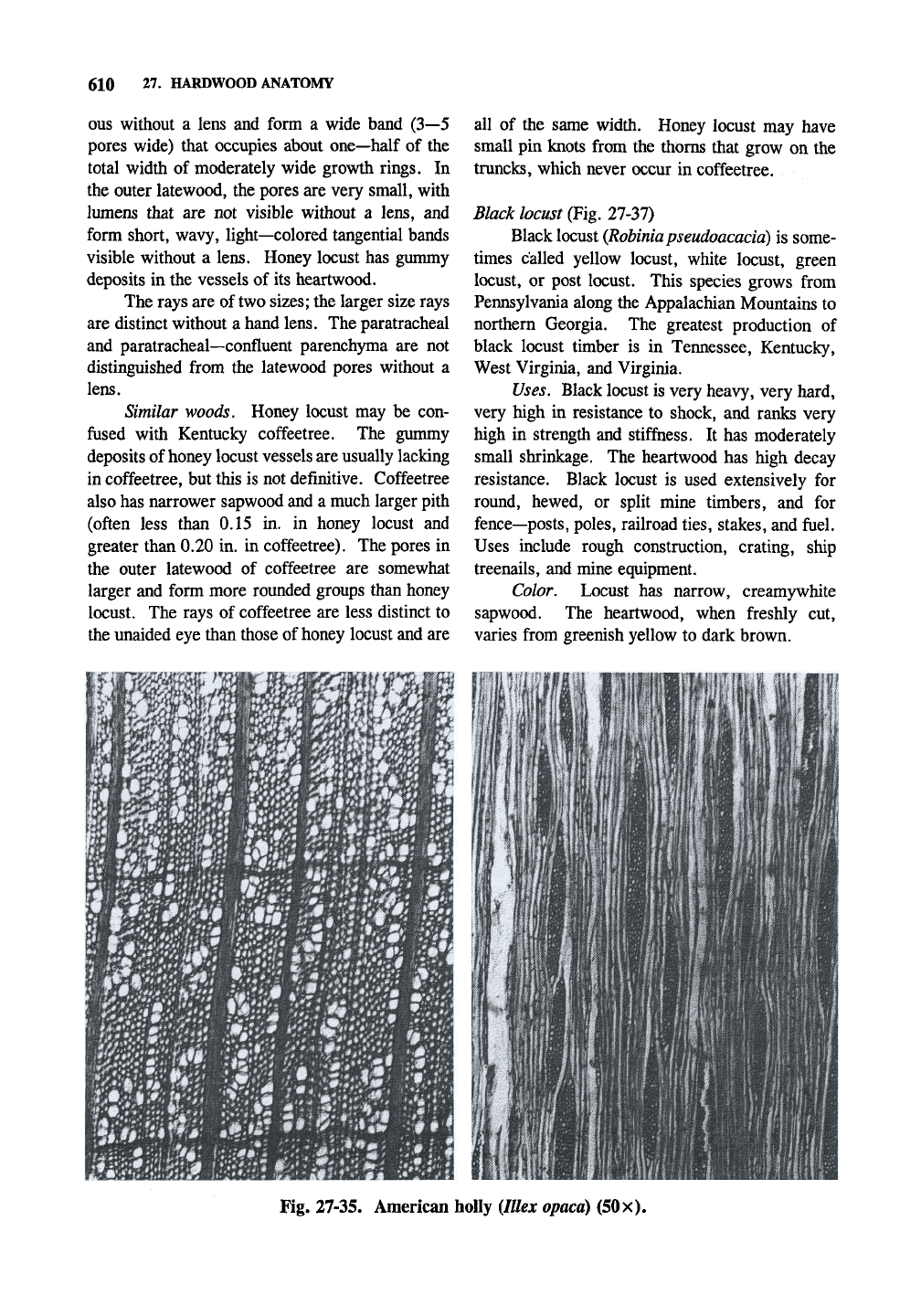
610 27. HARDWOOD ANATOMY
ous without a lens and form a wide band (3—5
pores wide) that occupies about one—half of the
total width of moderately wide growth rings. In
the outer latewood, the pores are very small, with
lumens that are not visible without a lens, and
form short, wavy, light—colored tangential bands
visible without a lens. Honey locust has gunmiy
deposits in the vessels of its heartwood.
The rays are of
two
sizes; the larger size rays
are distinct without a hand lens. The paratracheal
and paratracheal—confluent parenchyma are not
distinguished from the latewood pores without a
lens.
Similar woods. Honey locust may be con-
fused with Kentucky coffeetree. The gummy
deposits of honey locust vessels are usually lacking
in coffeetree, but this is not definitive. Coffeetree
also has narrower sapwood and a much larger pith
(often less than 0.15 in. in honey locust and
greater than 0.20 in. in coffeetree). The pores in
the outer latewood of coffeetree are somewhat
larger and form more rounded groups than honey
locust. The rays of coffeetree are less distinct to
the unaided eye than those of honey locust and are
all of the same width. Honey locust may have
small pin knots from the thorns that grow on the
truncks, which never occur in coffeetree.
Black locust (Fig. 27-37)
Black locust (Robiniapseudoacacia) is some-
times called yellow locust, white locust, green
locust, or post locust. This species grows from
Pennsylvania along the Appalachian Mountains to
northern Georgia. The greatest production of
black locust timber is in Tennessee, Kentucky,
West Virginia, and Virginia.
Uses. Black locust is very heavy, very hard,
very high in resistance to shock, and ranks very
high in strength and stiffness. It has moderately
small shrinkage. The heartwood has high decay
resistance. Black locust is used extensively for
round, hewed, or split mine timbers, and for
fence—posts, poles, railroad ties, stakes, and fiiel.
Uses include rough construction, crating, ship
treenails, and mine equipment.
Color. Locust has narrow, creamywhite
sapwood. The heartwood, when freshly cut,
varies from greenish yellow to dark brown.
Kg. 27-35. American holly (Illex
opaca)
(50x).
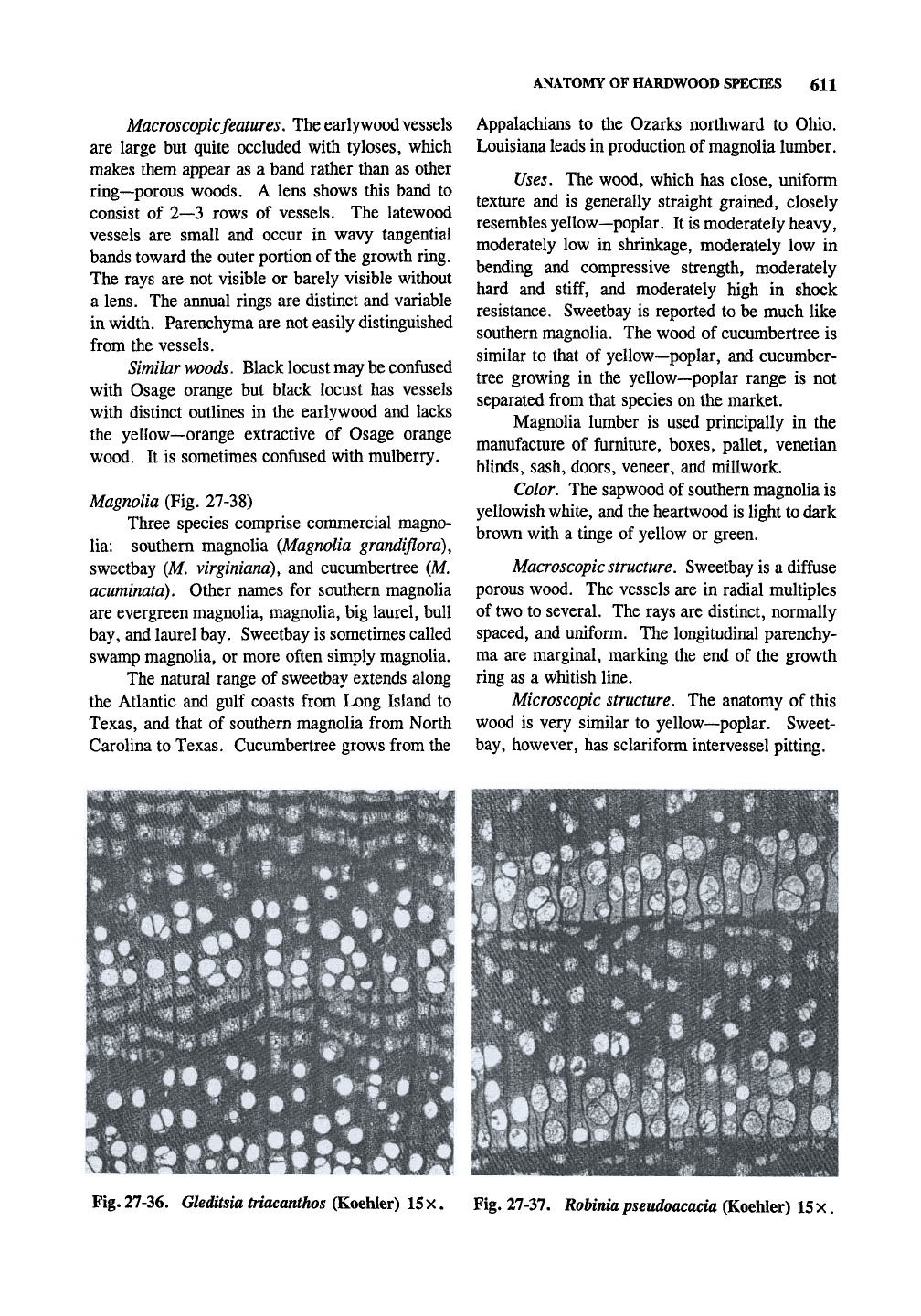
ANATOMY OF HARDWOOD SPECIES 611
Macroscopic features. The earlywood vessels
are large but quite occluded with tyloses, which
makes them appear as a band rather than as other
ring—porous woods, A lens shows this band to
consist of 2—3 rows of vessels. The latewood
vessels are small and occur in wavy tangential
bands toward the outer portion of
the
growth ring.
The rays are not visible or barely visible without
a lens. The annual rings are distinct and variable
in width. Parenchyma are not easily distinguished
from the vessels.
Similar
woods.
Black locust may be confused
with Osage orange but black locust has vessels
with distinct outlines in the earlywood and lacks
the yellow—orange extractive of Osage orange
wood. It is sometimes confused with mulberry.
Magnolia (Fig. 27-38)
Three species comprise commercial magno-
lia: southern magnolia {Magnolia grandiflora),
sweetbay (M. virginiana), and cucumbertree (M.
acuminata). Other names for southern magnolia
are evergreen magnolia, magnolia, big laurel, bull
bay, and laurel bay. Sweetbay is sometimes called
swamp magnolia, or more often simply magnolia.
The natural range of sweetbay extends along
the Atlantic and gulf coasts from Long Island to
Texas, and that of southern magnolia from North
Carolina to Texas. Cucumbertree grows from the
Appalachians to the Ozarks northward to Ohio.
Louisiana leads in production of magnolia lumber.
Uses. The wood, which has close, uniform
texture and is generally straight grained, closely
resembles yellow—poplar. It is moderately heavy,
moderately low in shrinkage, moderately low in
bending and compressive strength, moderately
hard and
stiff,
and moderately high in shock
resistance. Sweetbay is reported to be much like
southern magnolia. The wood of cucumbertree is
similar to that of yellow—poplar, and cucumber-
tree growing in the yellow—poplar range is not
separated from that species on the market.
Magnolia lumber is used principally in the
manufacture of furniture, boxes, pallet, Venetian
blinds, sash, doors, veneer, and millwork.
Color. The sapwood of southern magnolia is
yellowish
white,
and the heartwood is light to dark
brown with a tinge of yellow or green.
Macroscopic
structure.
Sweetbay is a diffuse
porous wood. The vessels are in radial multiples
of two to several. The rays are distinct, normally
spaced, and uniform. The longitudinal parenchy-
ma are marginal, marking the end of the growth
ring as a whitish line.
Microscopic structure. The anatomy of this
wood is very similar to yellow—poplar. Sweet-
bay, however, has sclariform intervessel pitting.
lift
mMmmm
•4immi :^-^%.^ ":^r^k.0
Fig.
27-36.
Gleditsia triacanthos
(Koehler) 15 X. Fig. 27-37.
Robinia pseudoacacia
(Koehler) 15 x.

612 27. HARDWOOD ANATOMY
Maple (Figs. 27-39 to 27-41)
Commercial species of maple in the U.S.
include sugar maple {Acer saccharum), black
maple
(^4.
nigrum), silver maple
(^4.
saccharinum),
red maple {A, rubrum), boxelder {A. negundo),
and bigleaf maple (^4. macrophyllum). Sugar
maple is also known as hard maple, rock maple,
sugar tree, and black ample; black maple as hard
maple, black sugar maple, and sugar maple; silver
maple as white maple, river maple, water maple,
and swamp maple; red maple as soft maple, water
maple, scarlet maple, white maple, and swamp
maple; boxelder as Manitoba maple, ash—leaved
maple, three—leaved maple, and cut—leaved
maple; and bigleaf maple as Oregon maple. The
Middle Atlantic and Lake States account for about
two—thirds of the maple production.
Uses. The wood of sugar maple and black
maple is known as hard maple; that of silver
maple, red maple, and boxelder as soft maple.
Hard maple has a fme, uniform texture. It is
heavy, strong,
stiff,
hard, resistant to shock, and
has large shrinkage. Sugar maple is generally
straight grained but also occurs as "bird's eye,"
"curly," and "fiddleback" grain. Soft maple.
Fig. 27-39. Acer macrophyllum.
Fig. 27-38. Cucumbertree
{Magnolia acuminata)
(50x).
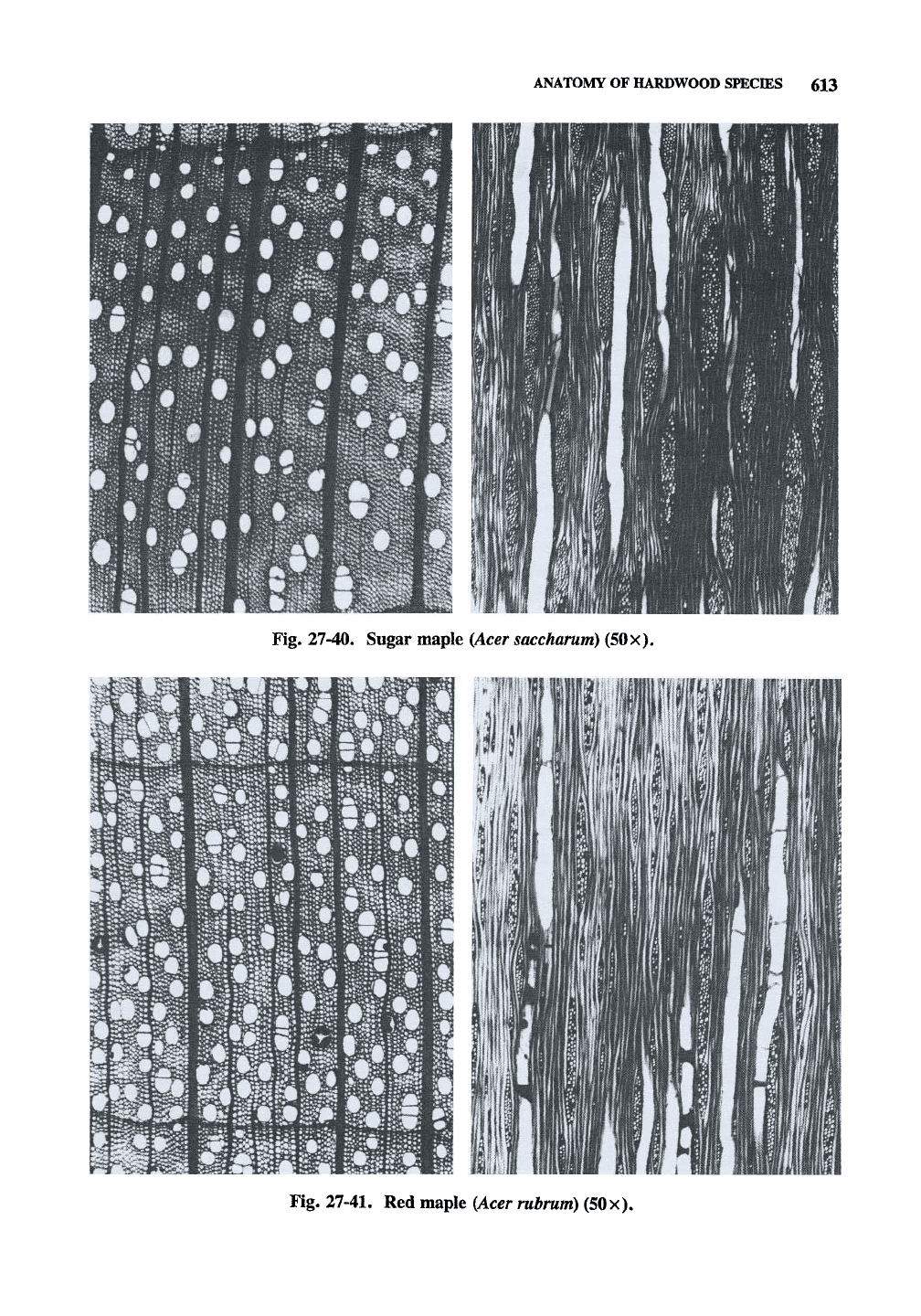
ANATOMY OF HARDWOOD SPECIES 613
Fig. 27-40. Sugar maple (Acer
saccharum) (50
X).
Fig.
27-41.
Red maple {Acer
rubrum)
(50x).
